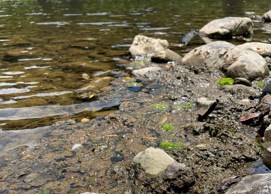Keeping your dog safe and healthy this summer
A trip to the river or lake is a lot of fun for dogs and their owners alike. Knowing how to keep your dog safe from toxic algae means you are able to relax and enjoy the adventure even more. Toxic algae can be seriously harmful to dogs and people, even in small amounts (the size of a 50 cent piece). This factsheet covers what to look for.
What to do
-
The best thing you can do to keep yourself, your kids and your dog safe is to know what toxic algae looks like and avoid it.
-
If you are not sure, keep your dog on a lead and don’t let them in or near the water. Bring water from home for your dog so that they don’t need to drink out of the river or lake.
- Contact your vet as soon as possible if you suspect that your dog has eaten toxic algae.
Toxic algae
Toxic algae are naturally occurring in rivers and lakes in New Zealand, including waterways with good water quality. Most algae are harmless, if a bit slimy – but some types of algae (known scientifically as cyanobacteria) can produce toxins, which are harmful to humans and animals when eaten, even licked, or when water containing the toxins is swallowed.
Toxic algae are present at low levels in many of our waterways. However toxic algae can form extensive 'blooms', and are more common during the summer months, when low rainfall, warm temperatures, the right level of nutrients and more sunlight create an environment where it can thrive. Scientists do not yet understand when and why these algae turns toxic, so to be safe, always treat it as toxic.
Dogs are particularly susceptible to poisoning from toxic algae as they can be attracted to it's musty smell. Dogs deaths have been reported from sites where toxic algae have been present in small amounts, and at levels below the threshold for public health warnings at monitored swim sites. It is important to be extra cautious in areas where toxic algae can be present. Your local regional council or unitary authority can advise on known toxic algae 'hotspots' in your region.
What to look for in rivers
In parts of stony based rivers toxic algae form soft, leathery-looking mats on rocks in the riverbed. These mats range in colour from blackish/brown to dark green.
These mats can come loose and wash up on the edge of the rivers, or form ‘floating rafts’ in shallow areas. As they dry out they turn light brown or white and look like dried leaves or cowpats. They produce a strong musty smell, and this is when it poses the biggest risk to our dogs, as they love the smell and many dogs will try to eat it if they get the chance.
Toxic algae on river stones


Toxic algae 'floating rafts' detached at river edge
What to look for in lakes and ponds
Toxic algae grows within the water column in lakes and cause the water to become murky or cloudy.
Free-floating algal blooms in lakes are generally green in colour and can look like paint, petrol or pea soup. It can also form foam or scum on the water’s surface, especially at the water’s edge. Sometimes blooms may not be very visible.

Algal bloom in a lake
What if my dog has eaten toxic algae?
If you suspect that your dog has eaten toxic algae, you should contact your vet as soon as possible. Signs a dog has been poisoned by toxic algae include:
- lethargy
- muscle tremors
- fast breathing
- twitching
- paralysis
- convulsions
In extreme cases, death can occur within 30 minutes after these signs appear.
What if I see new toxic algal blooms?
Council staff monitor for toxic algae in rivers and lakes where blooms are known to occur, particularly over the summer months. Keep up-to-date by checking for any warnings and alerts from authorities. Council's cannot monitor all areas, and as blooms can occur very suddenly, please learn what to look for to keep your dog safe. It is a good idea to alert your regional or unitary council when you see algal blooms so they can warn other people.
Find out more about toxic algae here


